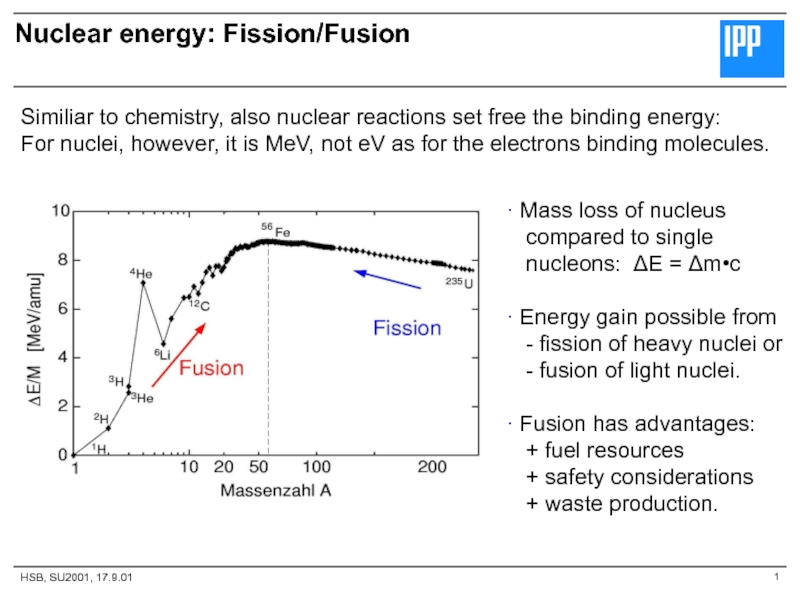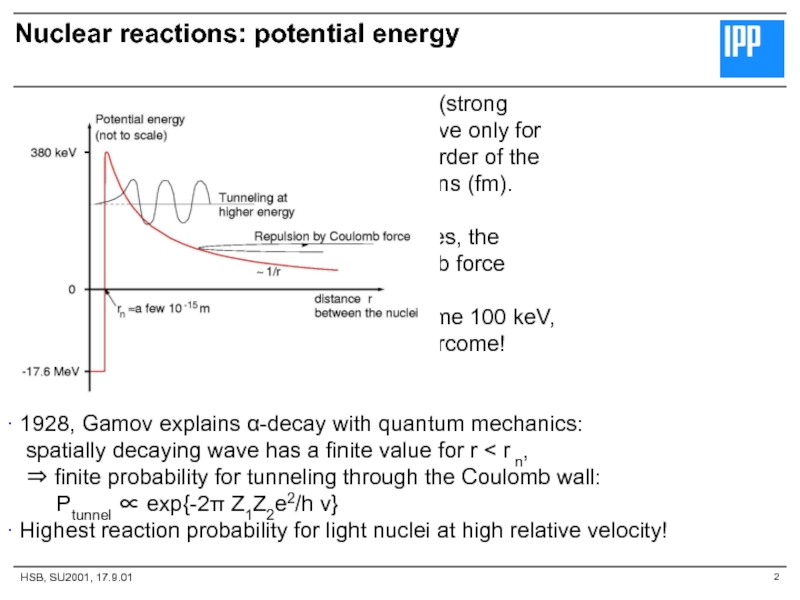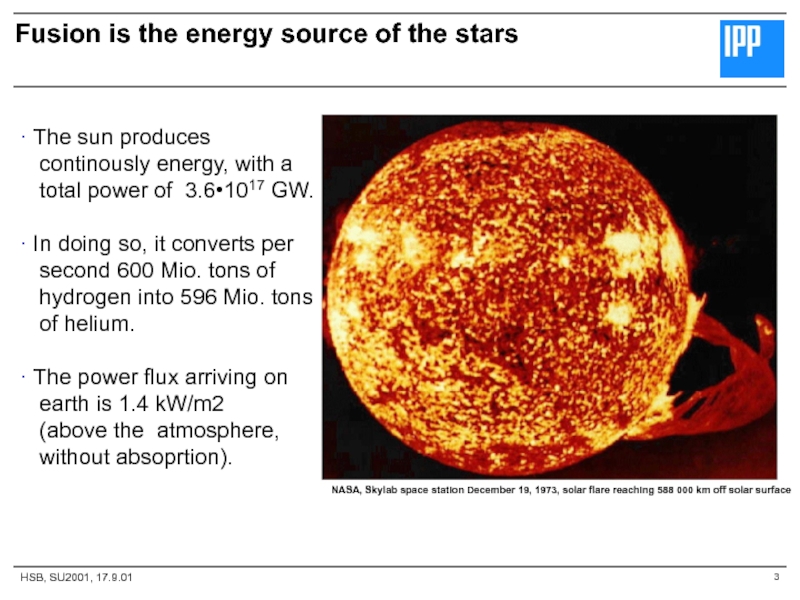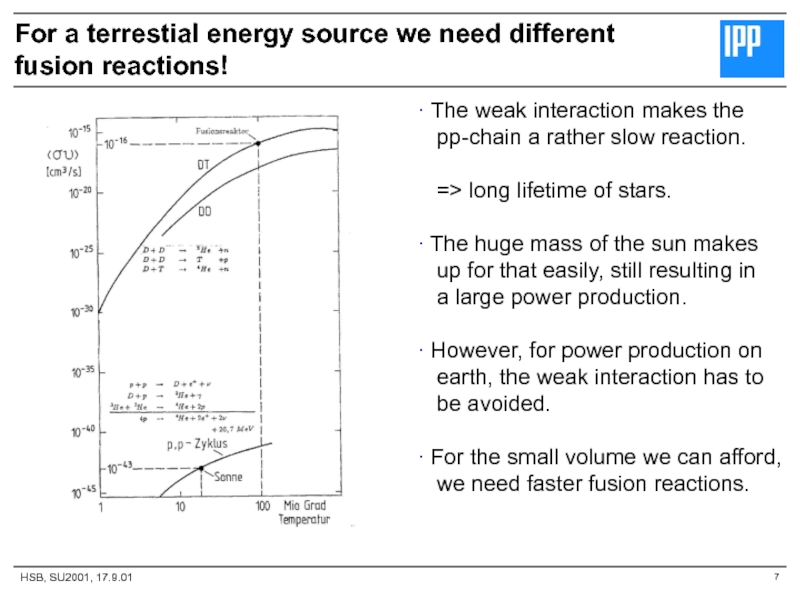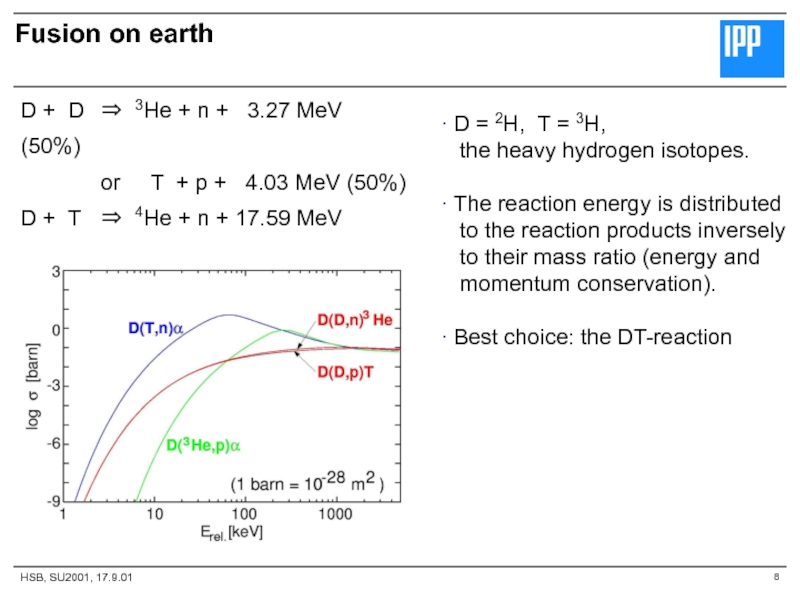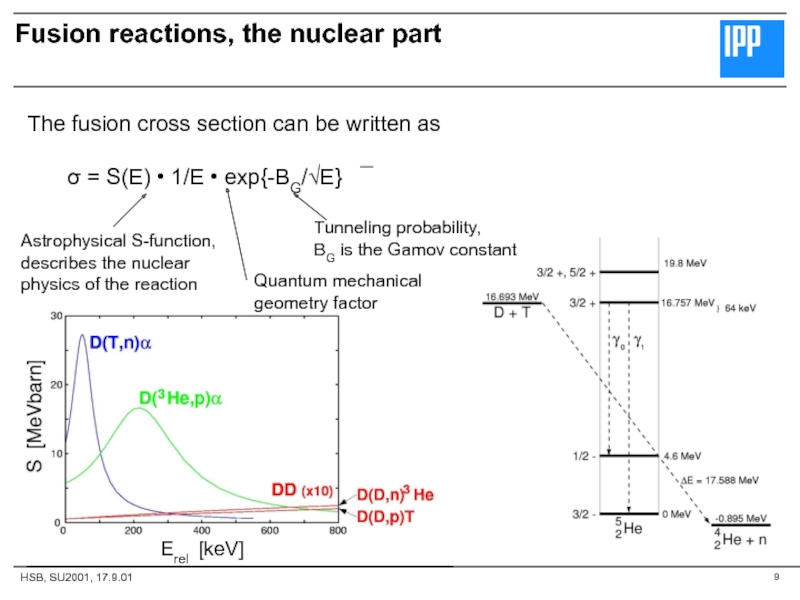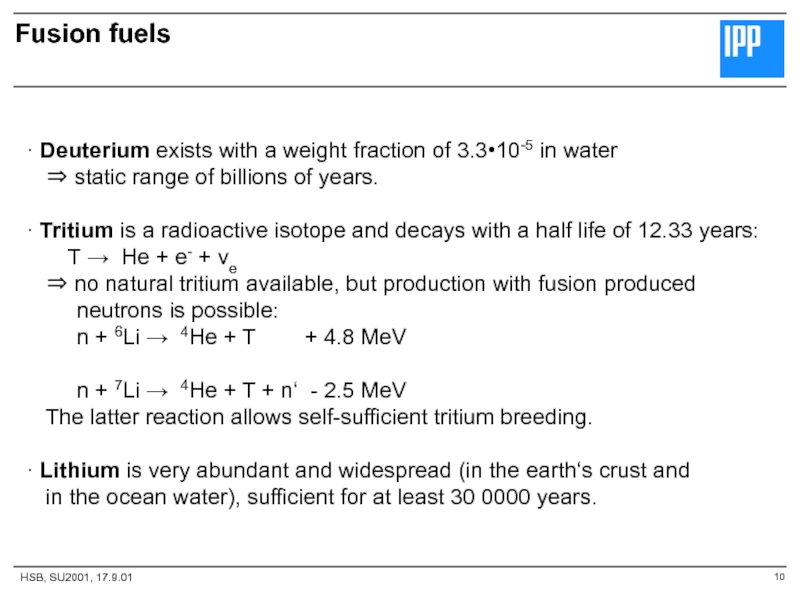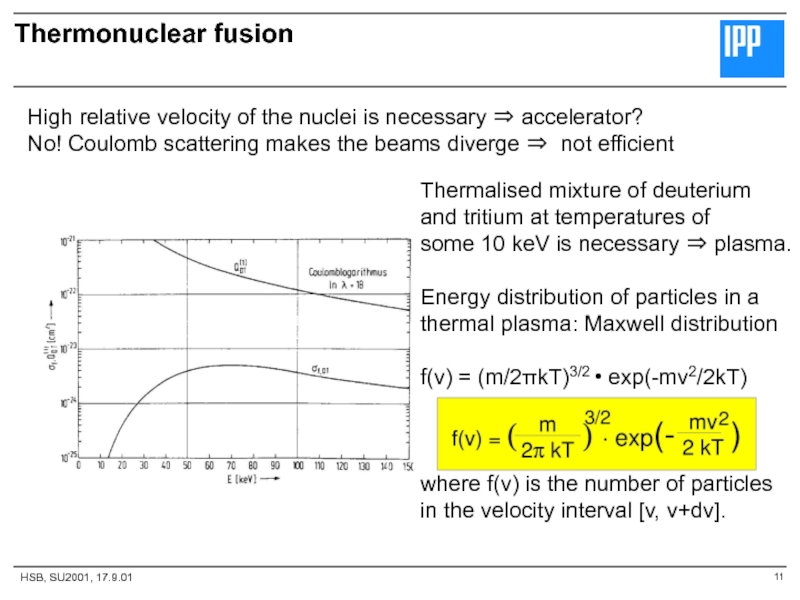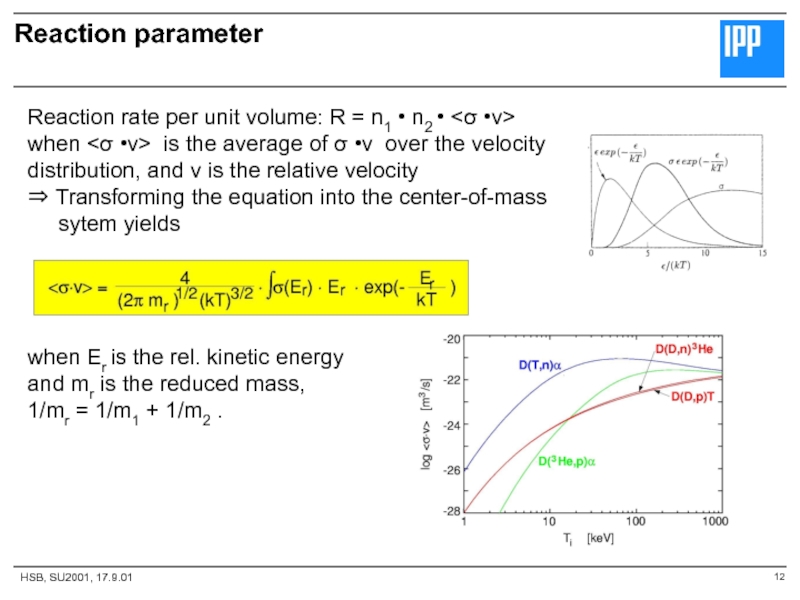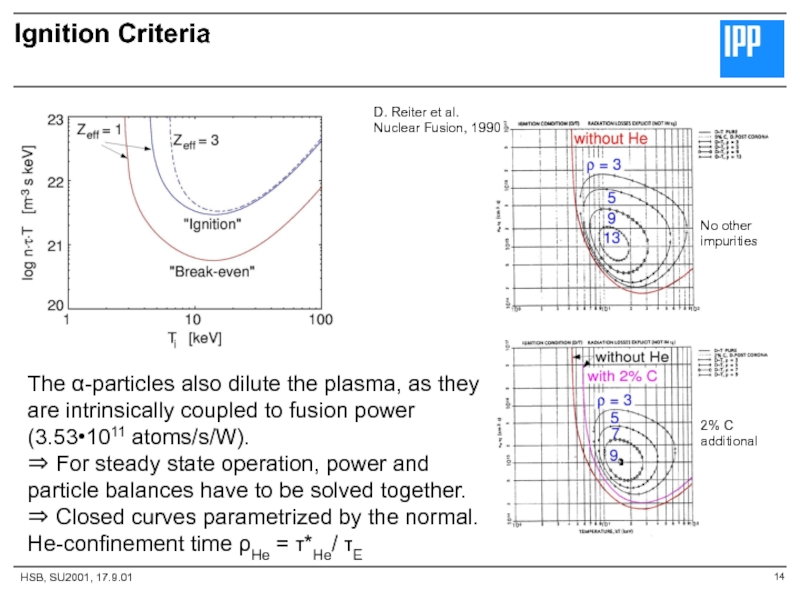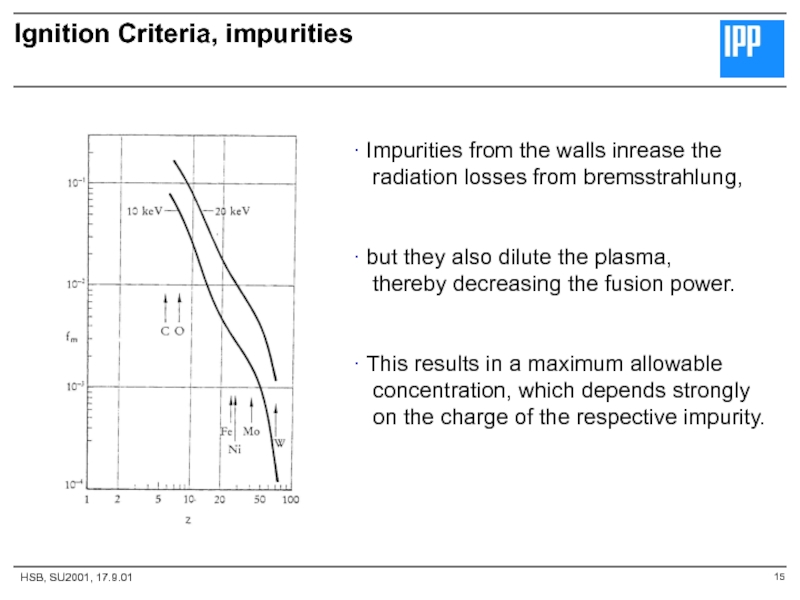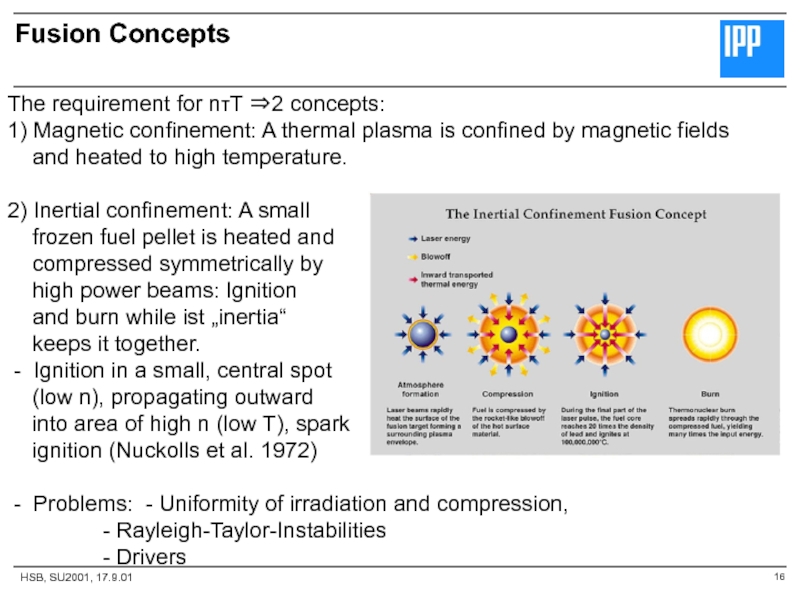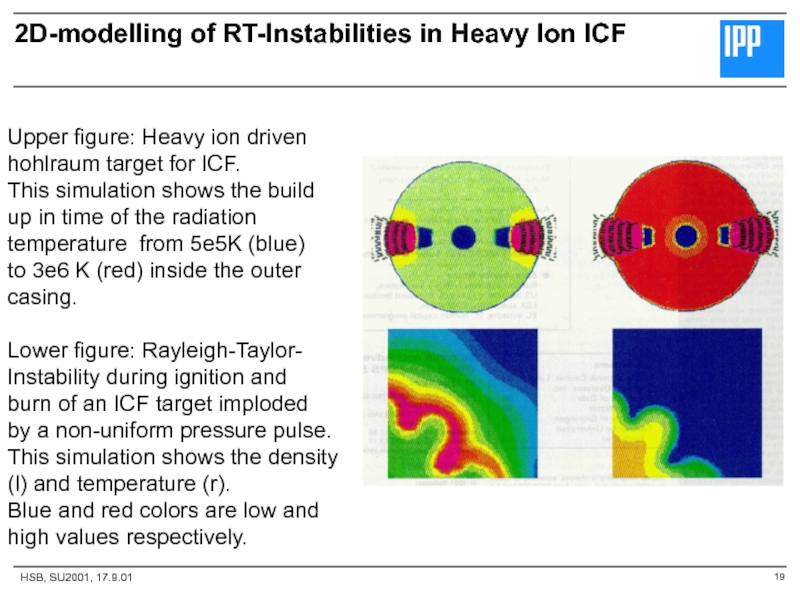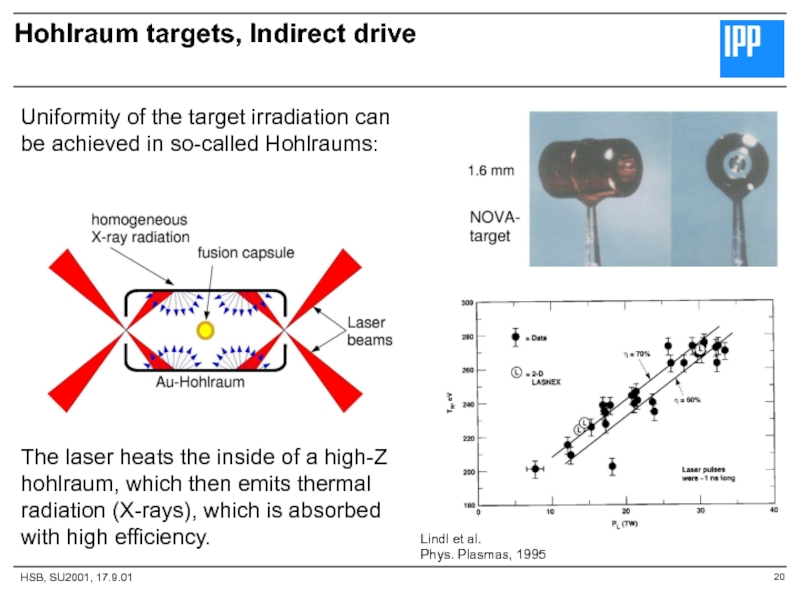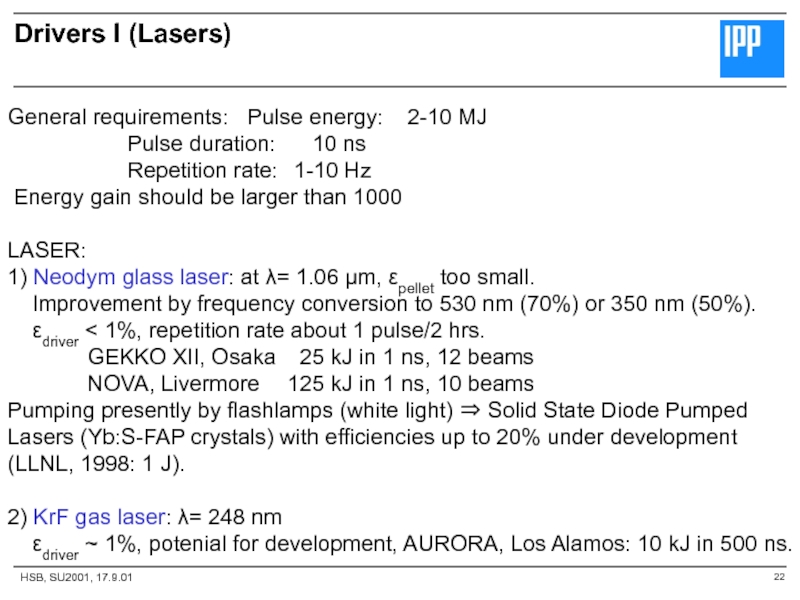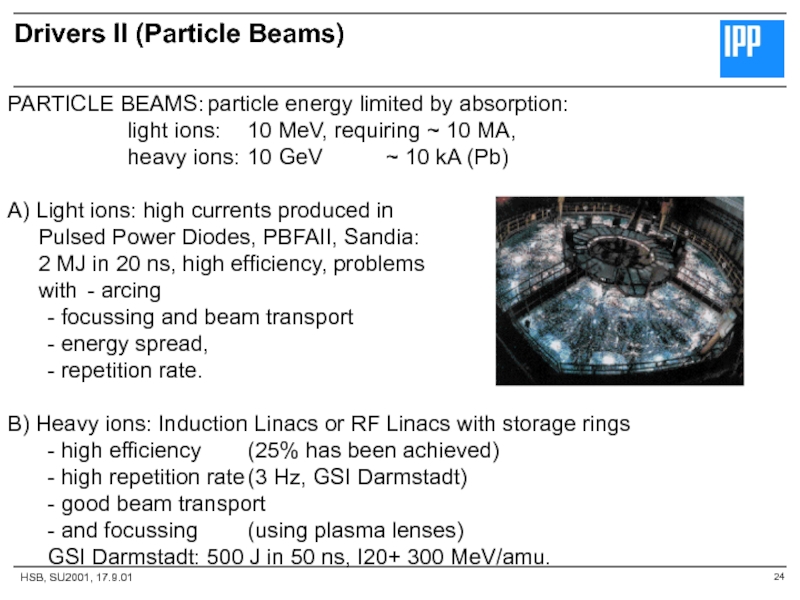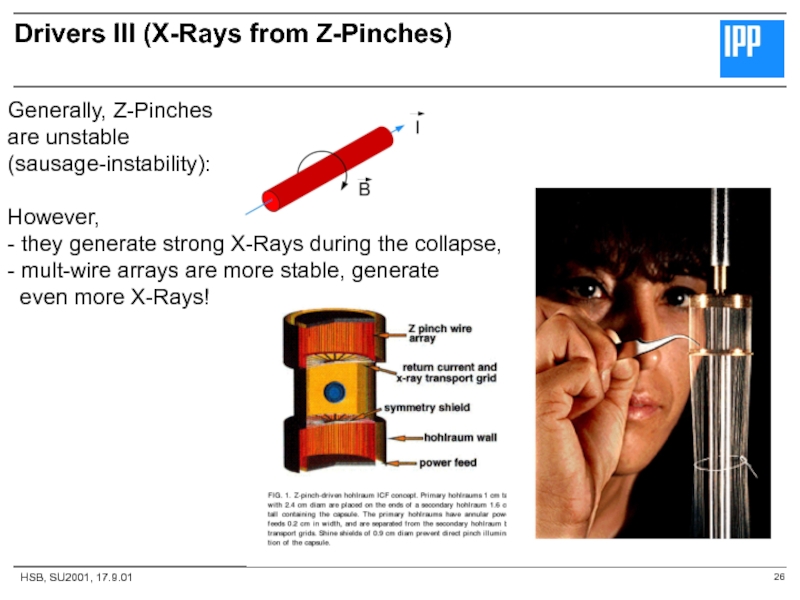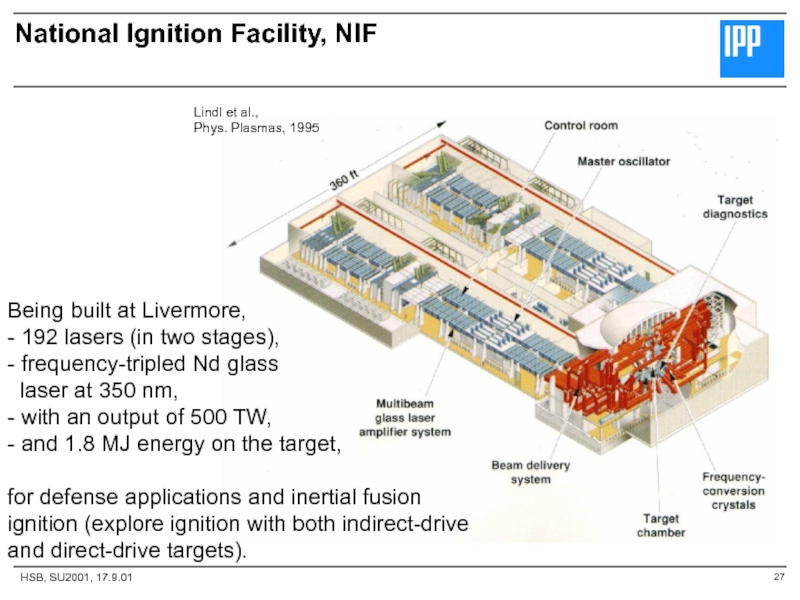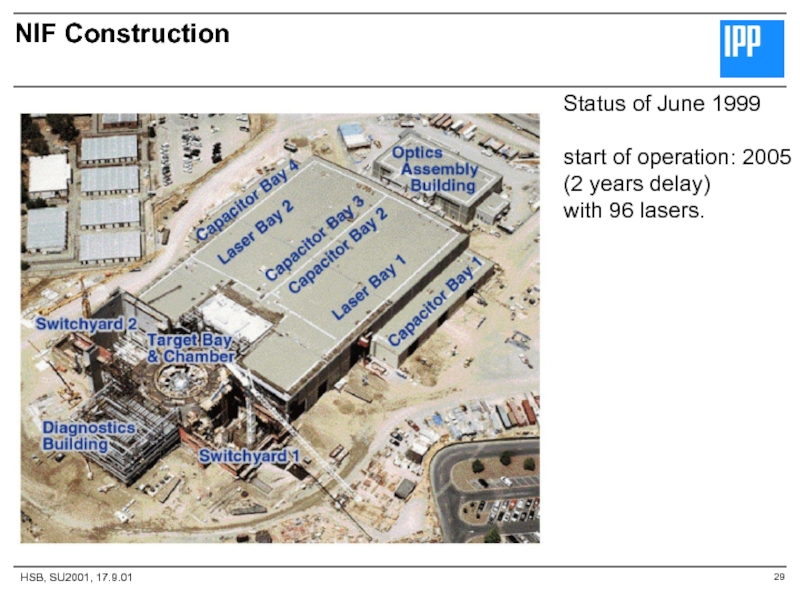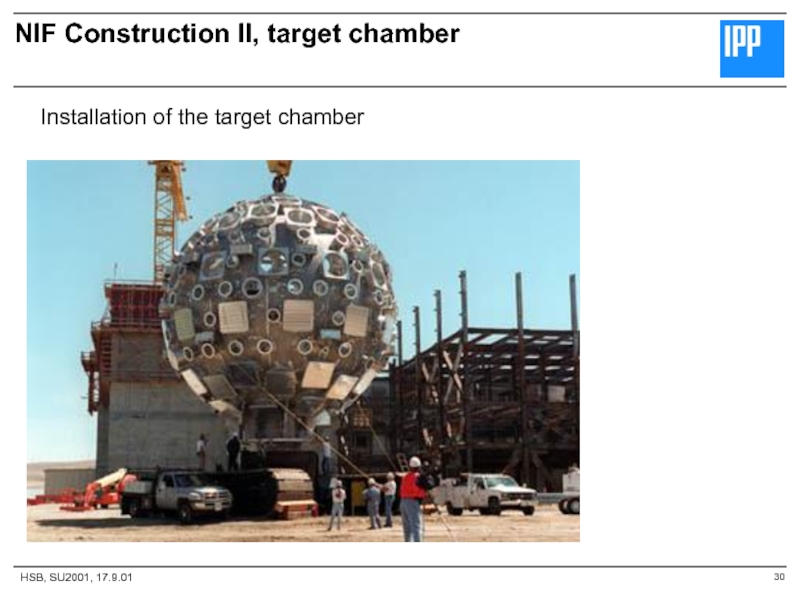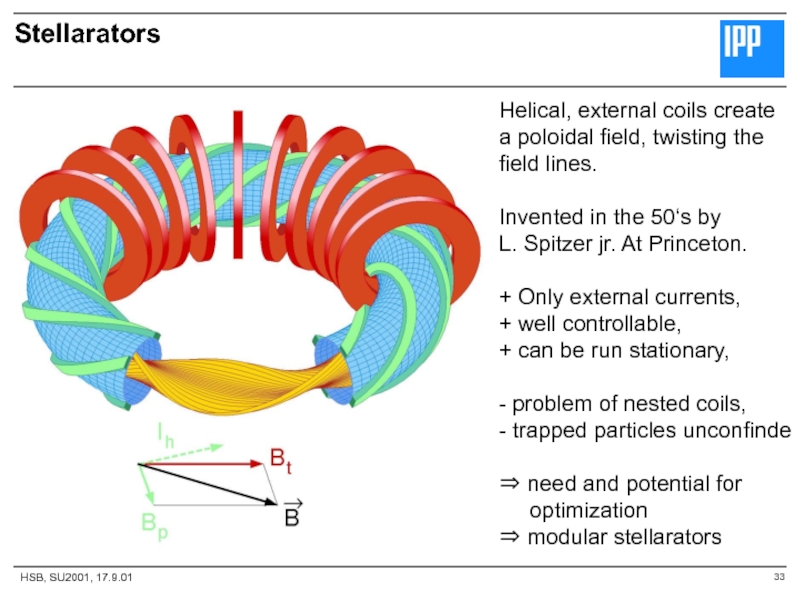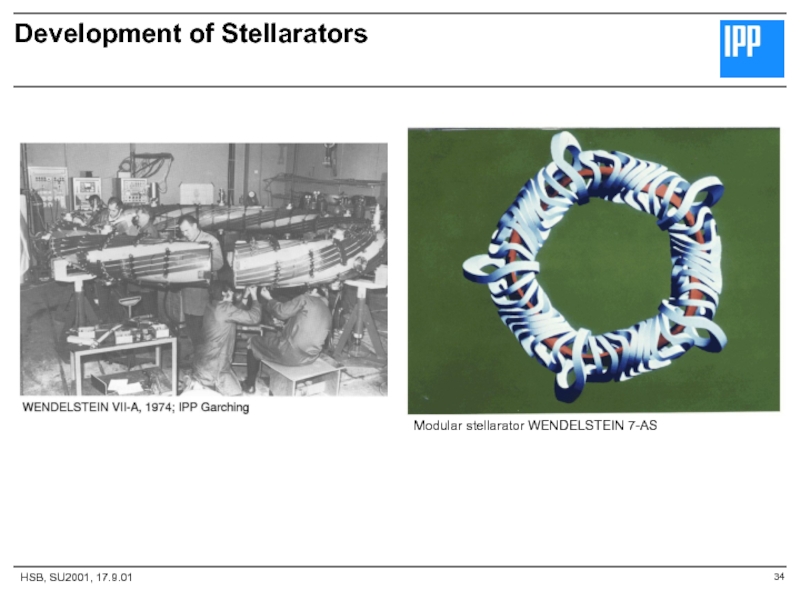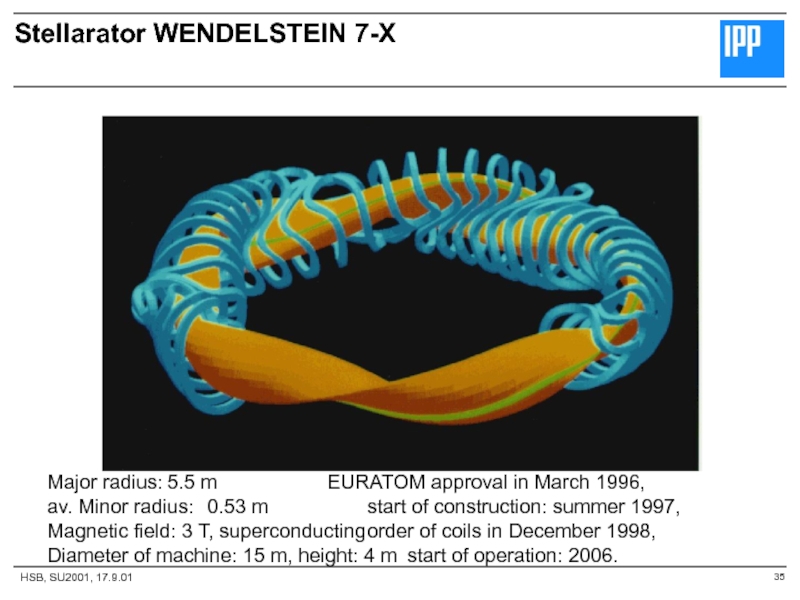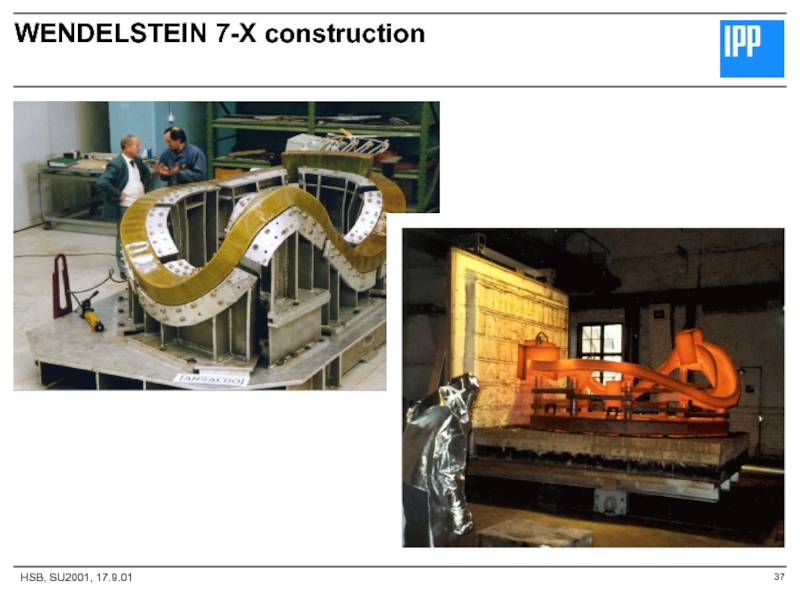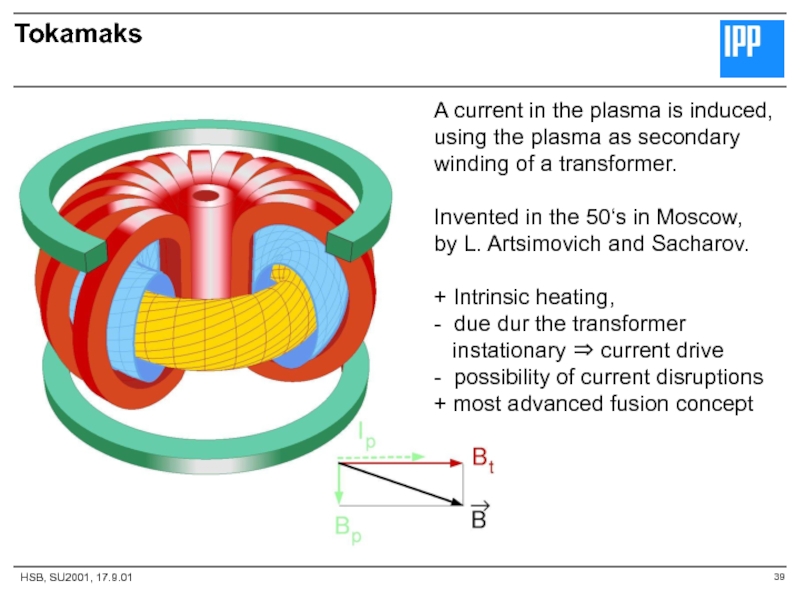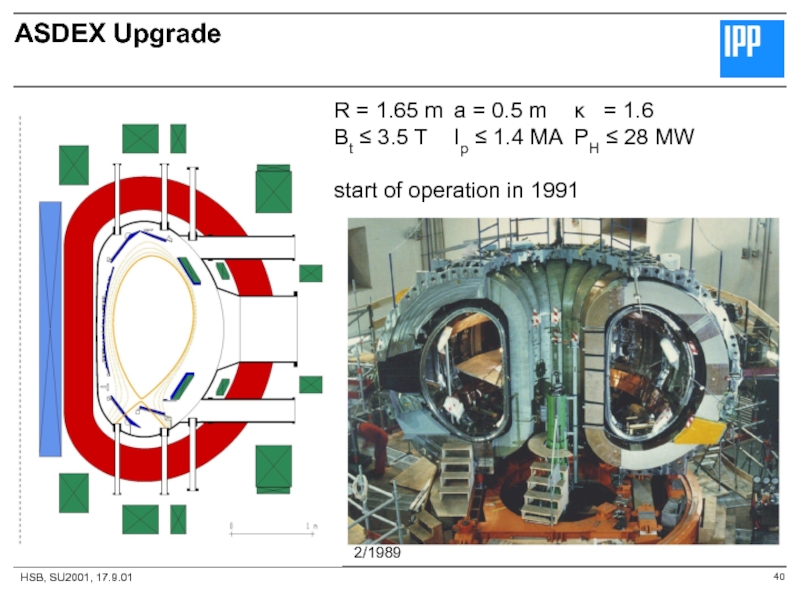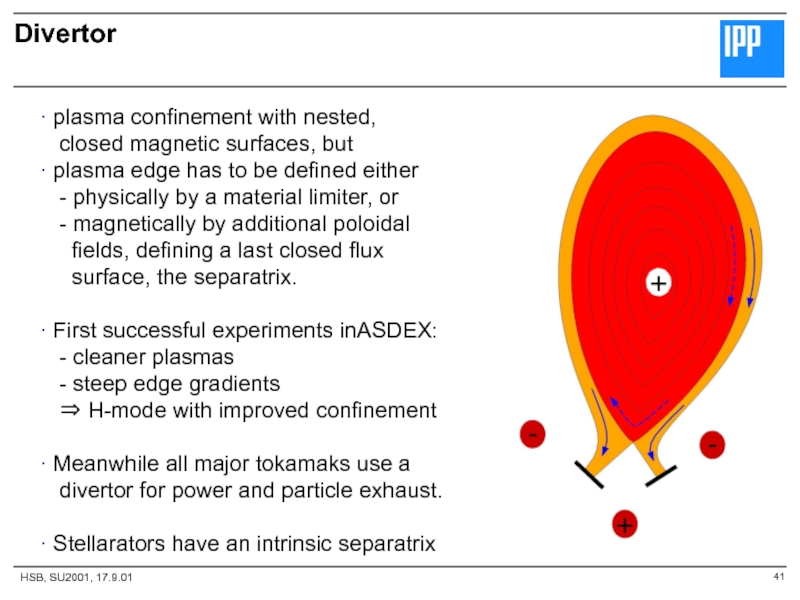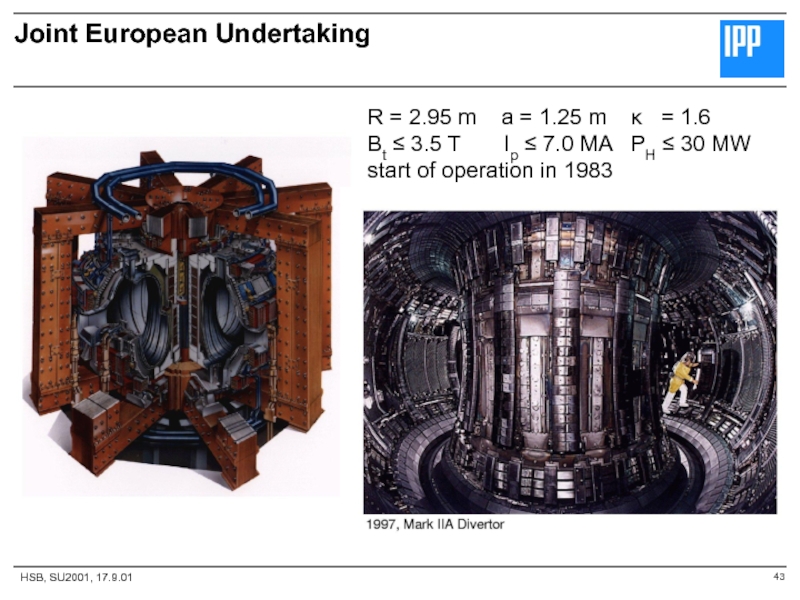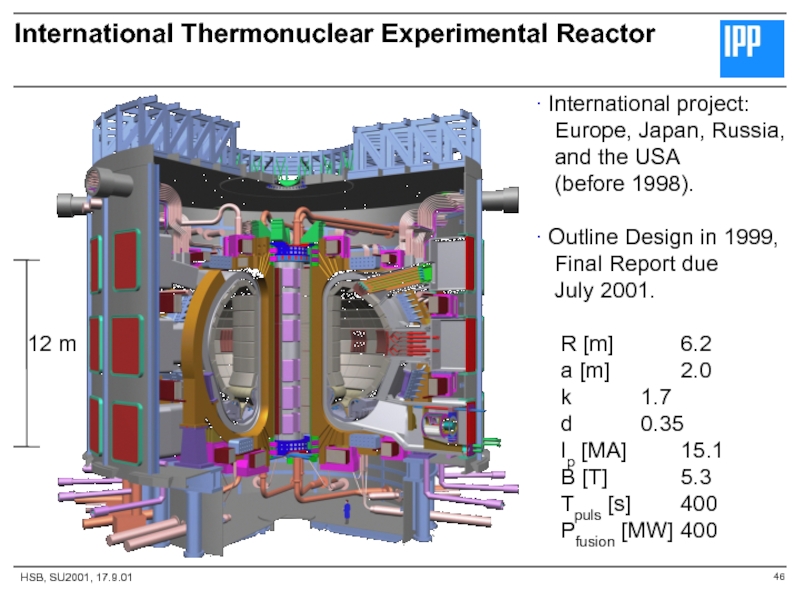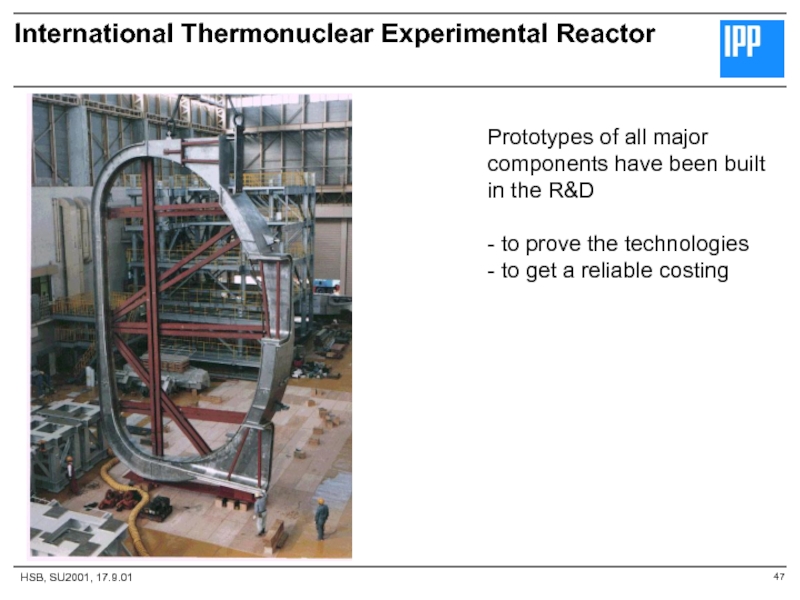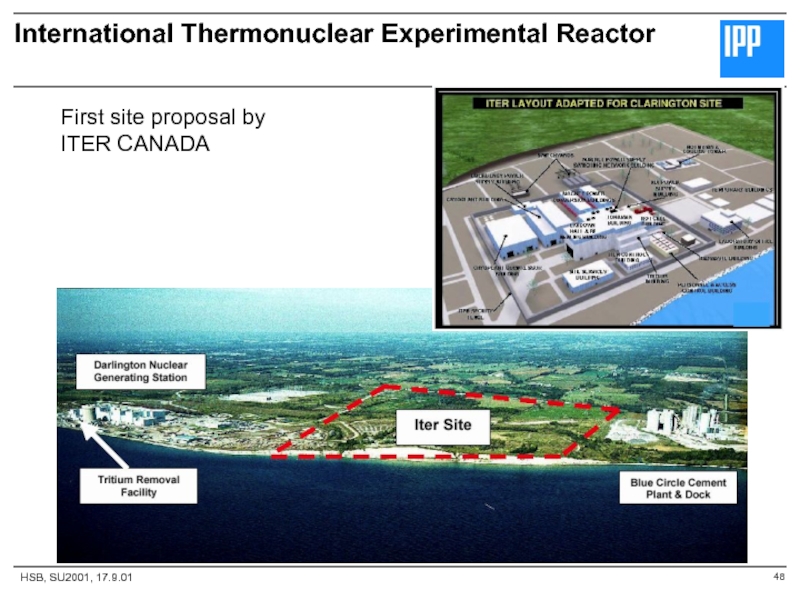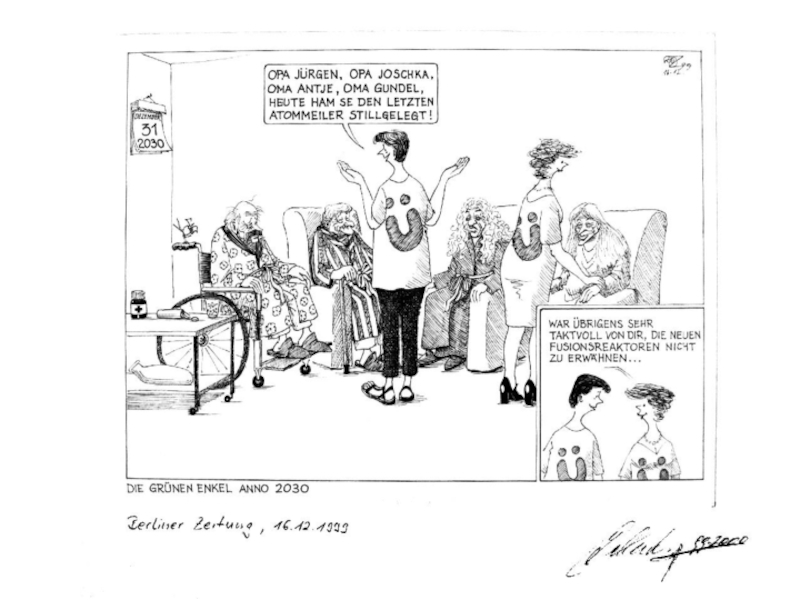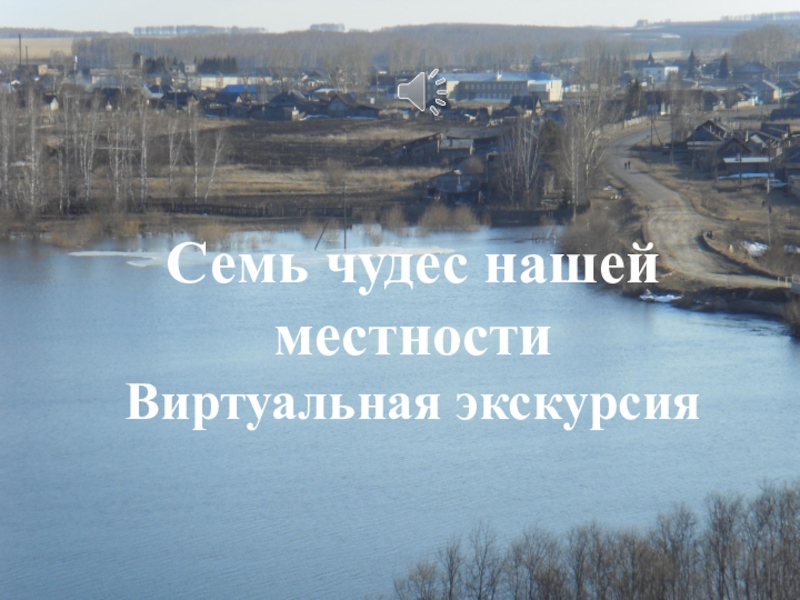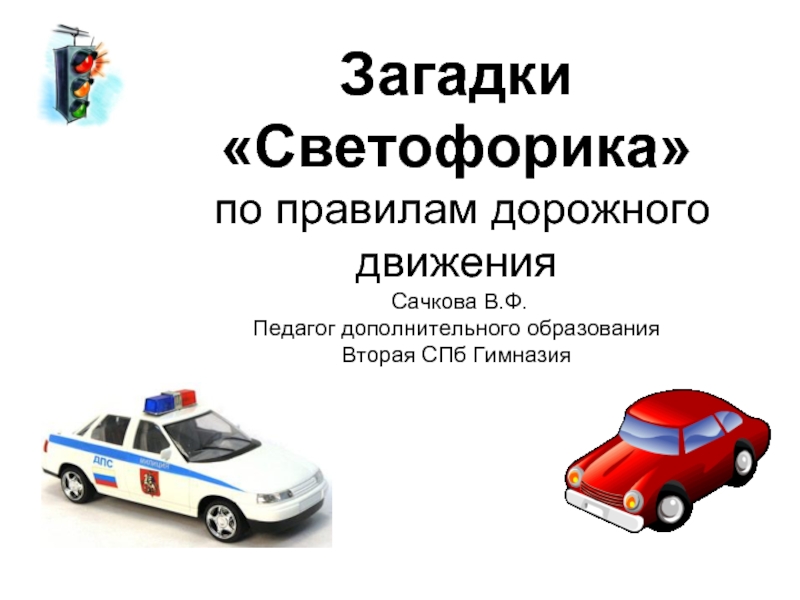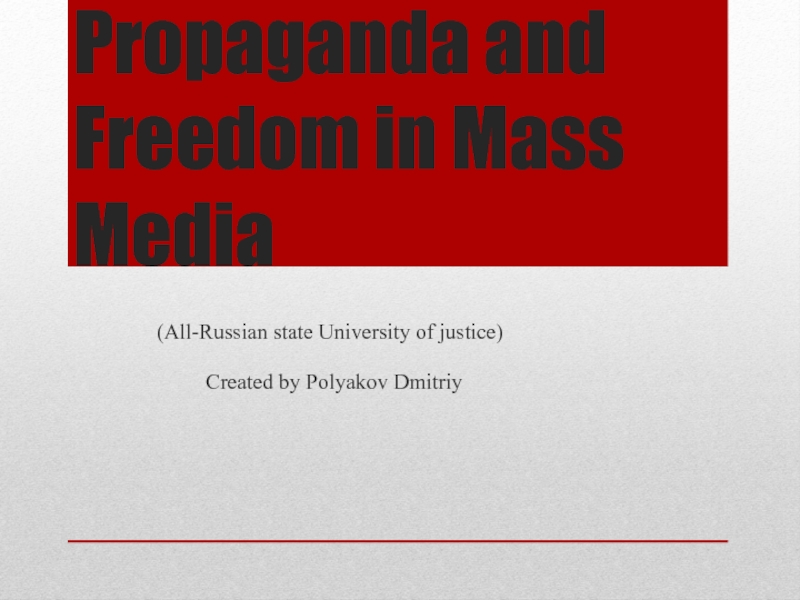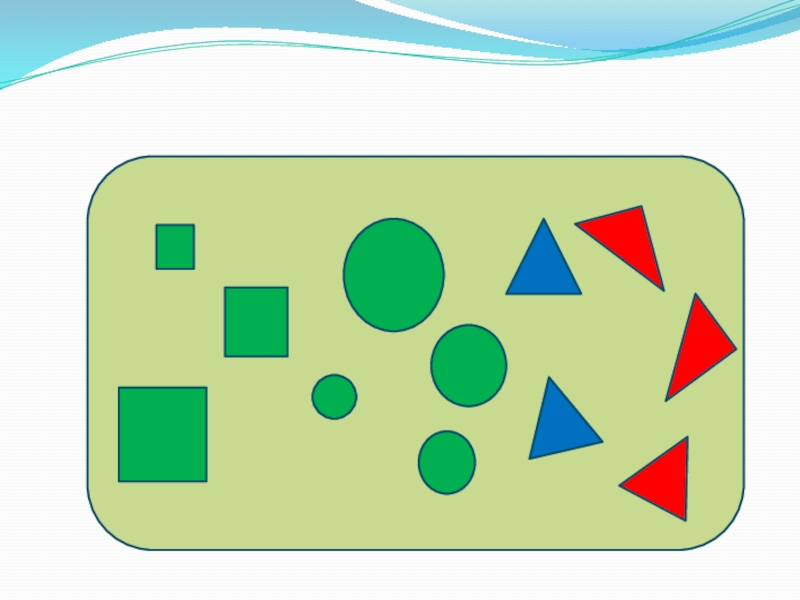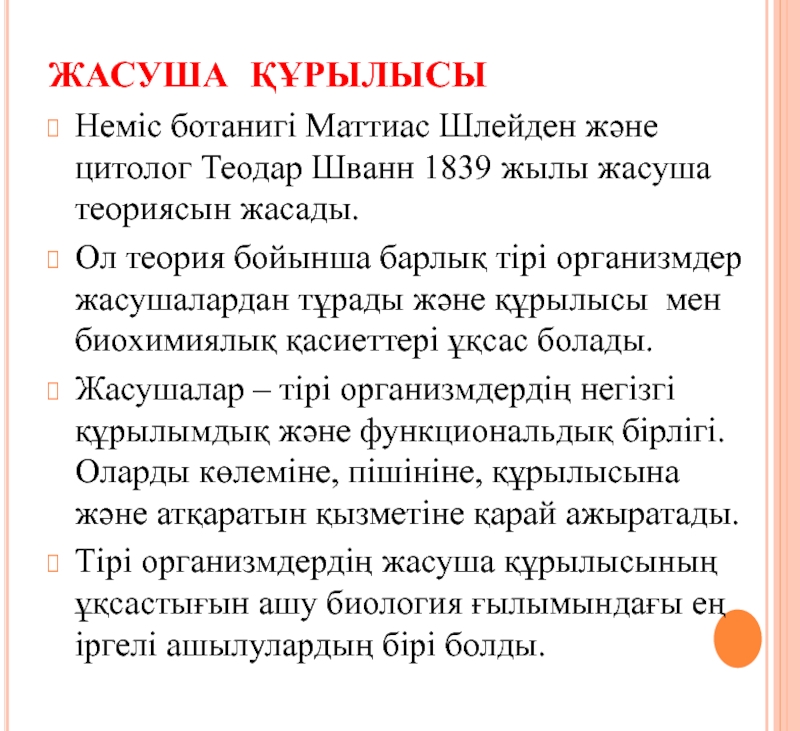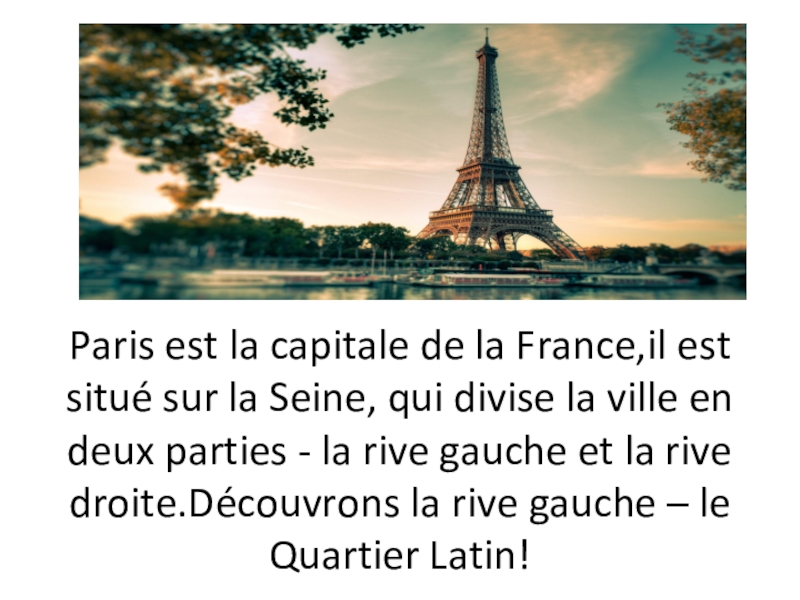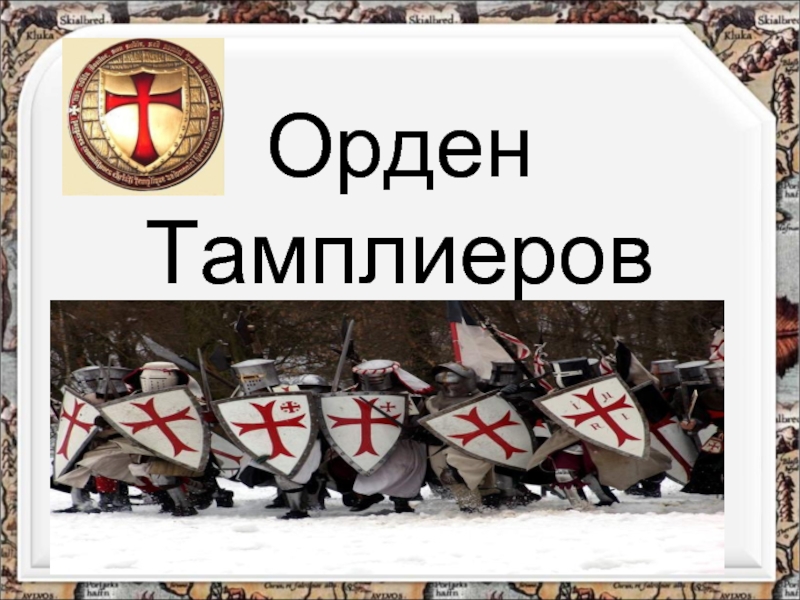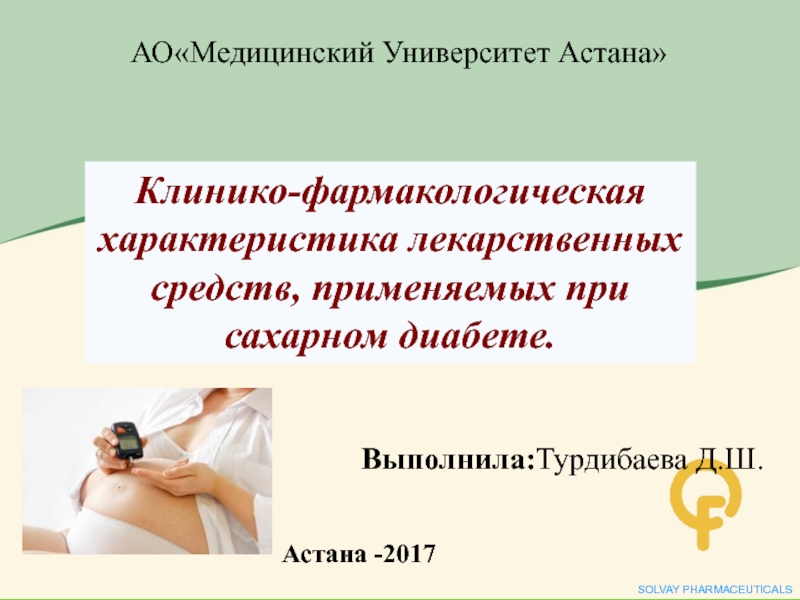Слайд 1
HSB, SU2001, 17.9.01
Max-Planck Institut
für Plasmaphysik
Introduction to Nuclear Fusion
H.-S. Bosch
Max-Planck-Institut für
Plasmaphysik,
IPP-Euratom Association, D-85748 Garching
Fusion in the stars
Fusion research
on earth
- Inertial Confinement Fusion
- Magnetic Confinement Fusion (MCF)
Prospects for a fusion reactor
IPP Summer University on Plasma Physics, Garching, Germany, 17-21 September 2001
Слайд 2
HSB, SU2001, 17.9.01
Nuclear energy: Fission/Fusion
1
Mass loss of nucleus
compared to single
nucleons: E = m•c
Energy gain possible from
- fission of heavy nuclei or
- fusion of light nuclei.
Fusion has advantages:
+ fuel resources
+ safety considerations
+ waste production.
Similiar to chemistry, also nuclear reactions set free the binding energy:
For nuclei, however, it is MeV, not eV as for the electrons binding molecules.
Слайд 3
HSB, SU2001, 17.9.01
Nuclear reactions: potential energy
2
The nuclear force
(strong
interaction) is active only for
distances in the order of the
nucleus dimensions (fm).
For larger distances, the
repulsive Coulomb force
dominates
Potential wall: some 100 keV,
impossible to overcome!
1928, Gamov explains -decay with quantum mechanics:
spatially decaying wave has a finite value for r < r n,
finite probability for tunneling through the Coulomb wall:
Ptunnel exp{-2 Z1Z2e2/h v}
Highest reaction probability for light nuclei at high relative velocity!
Слайд 4
HSB, SU2001, 17.9.01
Fusion is the energy source of the stars
3
The sun produces
continously energy, with a
total power of 3.6•1017 GW.
In doing so, it converts per
second 600 Mio. tons of
hydrogen into 596 Mio. tons
of helium.
The power flux arriving on
earth is 1.4 kW/m2
(above the atmosphere,
without absoprtion).
NASA, Skylab space station December 19, 1973, solar flare reaching 588 000 km off solar surface
Слайд 5
HSB, SU2001, 17.9.01
Solar fusion reactions: The pp-chain
4
The first step
involves the
weak interaction, trans-
forming a
proton into a
neutron, resulting in a
very long time scale,
i.e. small reaction rates.
This is the reason for the
long life time of stars.
The neutrinos from this reaction are the only particles to be observed
An alternative to this first step involves 3 body collisions, and is
therefore very rare: p + p + e- d + e
Fusion reactions also create the heavier nuclei in the stars
stellar Nucleosynthesis
Слайд 6
HSB, SU2001, 17.9.01
Solar fusion reactions: The pp-chain (II)
5
Early observations
of neutrinos
in a chlorine detector (Davis,
Homestake gold mine, South
Dakota, 1964) found only
~ 30% of the expected neutrino flux.
Sensitive only to neutrinos above
814 keV: 37Cl+ e 37Ar + e-
Measurements with a Cerenkov
detector (700 tons H2O, Kamiokande,
1989) saw ~ 44% of the expected
neutrinos.
Only in 1992 (GALLEX, Gran Sasso and SAGE, Caucasus), the low energy
neutrinos could be observed: 37Ga + e 37Ge + e-
These experiments found 50% and 58%, respectively, of the expected flux.
Solar modell? or Neutrino oscillations?
First indications of oscillations in Super-Kamiokande, 1998.
Слайд 7
HSB, SU2001, 17.9.01
The CNO-cycle
(Bethe-Weizsäcker-cycle)
6
Discovered in 1938, independently by
Hans Bethe (Cornell University) and
Carl-Friedrich von Weiysäcker.
Catalytic process at temperatures
above 1.5 keV, based on 12C.
Not important in the sun, but for
all larger (i.e. hotter) stars.
Net reaction:
4 p 4He + 2 e+ + 2 + 3
Слайд 8
HSB, SU2001, 17.9.01
For a terrestial energy source we need different
fusion reactions!
7
The weak interaction makes the
pp-chain
a rather slow reaction.
=> long lifetime of stars.
The huge mass of the sun makes
up for that easily, still resulting in
a large power production.
However, for power production on
earth, the weak interaction has to
be avoided.
For the small volume we can afford,
we need faster fusion reactions.
Слайд 9
HSB, SU2001, 17.9.01
Fusion on earth
8
D = 2H, T =
3H,
the heavy hydrogen isotopes.
The reaction energy is
distributed
to the reaction products inversely
to their mass ratio (energy and
momentum conservation).
Best choice: the DT-reaction
D + D 3He + n + 3.27 MeV (50%)
or T + p + 4.03 MeV (50%)
D + T 4He + n + 17.59 MeV
D + 3He 4He + p + 18.35 MeV
Слайд 10
HSB, SU2001, 17.9.01
Fusion reactions, the nuclear part
9
The fusion cross section
can be written as
= S(E) • 1/E • exp{-BG/E}
Tunneling
probability,
BG is the Gamov constant
9
Quantum mechanical
geometry factor
Erel [keV]
Astrophysical S-function,
describes the nuclear
physics of the reaction
Слайд 11
HSB, SU2001, 17.9.01
Fusion fuels
10
Deuterium exists with a weight fraction
of 3.3•10-5 in water
static range of
billions of years.
Tritium is a radioactive isotope and decays with a half life of 12.33 years:
T He + e- + e
no natural tritium available, but production with fusion produced
neutrons is possible:
n + 6Li 4He + T + 4.8 MeV
n + 7Li 4He + T + n‘ - 2.5 MeV
The latter reaction allows self-sufficient tritium breeding.
Lithium is very abundant and widespread (in the earth‘s crust and
in the ocean water), sufficient for at least 30 0000 years.
Слайд 12
HSB, SU2001, 17.9.01
Thermonuclear fusion
11
High relative velocity of the nuclei
is necessary accelerator?
No! Coulomb scattering makes the beams diverge
not efficient
Thermalised mixture of deuterium
and tritium at temperatures of
some 10 keV is necessary plasma.
Energy distribution of particles in a
thermal plasma: Maxwell distribution
f(v) = (m/2kT)3/2 • exp(-mv2/2kT)
where f(v) is the number of particles
in the velocity interval [v, v+dv].
Слайд 13
HSB, SU2001, 17.9.01
Reaction parameter
12
Reaction rate per unit volume: R =
n1 • n2 •
when is
the average of •v over the velocity
distribution, and v is the relative velocity
Transforming the equation into the center-of-mass
sytem yields
< •v> (Er) • Er • exp(-Er/kT)
when Er is the rel. kinetic energy
and mr is the reduced mass,
1/mr = 1/m1 + 1/m2 .
Слайд 14
HSB, SU2001, 17.9.01
Lawson Criterion
13
In 1957 Lawson introduced power balances:
Break-even:
The fusion power
equals the loss by radiation,
(when c1
= 5.4•10-37 Wm3keV-1/2, and Zeff = niZi2/n is the effective plasma charge),
and by transport (diffusion, convection,
Charge-Exchange):
With nD= nT= n/2, Ti =Te =T we find a condition for the fusion product nT:
Ignition: The neutrons leave the plasma, the -particles are confined and
heat it. Only their energy should enter the balance! Efus E
Слайд 15
HSB, SU2001, 17.9.01
Ignition Criteria
14
D. Reiter et al.
Nuclear Fusion, 1990
No other
impurities
2%
C
additional
The -particles also dilute the plasma, as they
are intrinsically coupled
to fusion power
(3.53•1011 atoms/s/W).
For steady state operation, power and
particle balances have to be solved together.
Closed curves parametrized by the normal.
He-confinement time He = *He/ E
Слайд 16
HSB, SU2001, 17.9.01
Ignition Criteria, impurities
15
Impurities from the walls
inrease the
radiation losses from bremsstrahlung,
but they
also dilute the plasma,
thereby decreasing the fusion power.
This results in a maximum allowable
concentration, which depends strongly
on the charge of the respective impurity.
Слайд 17
HSB, SU2001, 17.9.01
Fusion Concepts
16
The requirement for nT 2 concepts:
1)
Magnetic confinement: A thermal plasma is confined by magnetic fields
and heated to high temperature.
2) Inertial confinement: A small
frozen fuel pellet is heated and
compressed symmetrically by
high power beams: Ignition
and burn while ist „inertia“
keeps it together.
- Ignition in a small, central spot
(low n), propagating outward
into area of high n (low T), spark
ignition (Nuckolls et al. 1972)
- Problems: - Uniformity of irradiation and compression,
- Rayleigh-Taylor-Instabilities
- Drivers
Слайд 18
HSB, SU2001, 17.9.01
RT-Instabilities, Homogeneity
18
Uniformity of the ablation front is
essential to prevent growth of
Rayleigh-Taylor instabilities.
1) High requirement for
surface finish of fuel capsules,
r/r < 0.08 m/1.11 mm = 7•10-8 (NIF-Design).
2) With direct drive, irradiation with many beams and high spatial
homogeneity of the beam profile is neccessary.
A lot of techniques have been developed, and absorption
inhomogeneities of about 3% rms have been achieved
(GEKKO, 1996).
3) Alternatively: Hohlraum
Слайд 19
HSB, SU2001, 17.9.01
2D-modelling of RT-Instabilities in Heavy Ion ICF
19
Upper figure:
Heavy ion driven
hohlraum target for ICF.
This simulation shows the build
up in time of the radiation
temperature from 5e5K (blue)
to 3e6 K (red) inside the outer
casing.
Lower figure: Rayleigh-Taylor-
Instability during ignition and
burn of an ICF target imploded
by a non-uniform pressure pulse.
This simulation shows the density
(l) and temperature (r).
Blue and red colors are low and
high values respectively.
Слайд 20
HSB, SU2001, 17.9.01
Hohlraum targets, Indirect drive
20
The laser heats the inside
of a high-Z
hohlraum, which then emits thermal
radiation (X-rays), which
is absorbed
with high efficiency.
Uniformity of the target irradiation can
be achieved in so-called Hohlraums:
Lindl et al.
Phys. Plasmas, 1995
Слайд 21
HSB, SU2001, 17.9.01
Drivers I (Lasers)
22
General requirements: Pulse energy: 2-10 MJ
Pulse duration:
10 ns
Repetition rate: 1-10 Hz
Energy gain should be larger
than 1000
LASER:
1) Neodym glass laser: at = 1.06 m, pellet too small.
Improvement by frequency conversion to 530 nm (70%) or 350 nm (50%).
driver < 1%, repetition rate about 1 pulse/2 hrs.
GEKKO XII, Osaka 25 kJ in 1 ns, 12 beams
NOVA, Livermore 125 kJ in 1 ns, 10 beams
Pumping presently by flashlamps (white light) Solid State Diode Pumped
Lasers (Yb:S-FAP crystals) with efficiencies up to 20% under development
(LLNL, 1998: 1 J).
2) KrF gas laser: = 248 nm
driver ~ 1%, potenial for development, AURORA, Los Alamos: 10 kJ in 500 ns.
Слайд 22
HSB, SU2001, 17.9.01
NOVA, Livermore
23
Dedicated in 1985:
10 beams, Nd glass laser,
30-40
kJ at 350 nm.
Target chamber
( 4.6m Al, 13 cm
thick)
Laser bay
(each frame contains 5
laser chains, 137 m long)
Слайд 23
HSB, SU2001, 17.9.01
Drivers II (Particle Beams)
24
PARTICLE BEAMS: particle energy limited by
absorption:
light ions: 10 MeV, requiring ~ 10 MA,
heavy ions: 10 GeV
~ 10 kA (Pb)
A) Light ions: high currents produced in
Pulsed Power Diodes, PBFAII, Sandia:
2 MJ in 20 ns, high efficiency, problems
with - arcing
- focussing and beam transport
- energy spread,
- repetition rate.
B) Heavy ions: Induction Linacs or RF Linacs with storage rings
- high efficiency (25% has been achieved)
- high repetition rate (3 Hz, GSI Darmstadt)
- good beam transport
- and focussing (using plasma lenses)
GSI Darmstadt: 500 J in 50 ns, I20+ 300 MeV/amu.
Слайд 24
HSB, SU2001, 17.9.01
Heavy Ion Driven Fusion, Reactor Study HIBALL
25
From:
R.
Bock
Phys. Bl. 37 (1981) 214
Слайд 25
HSB, SU2001, 17.9.01
Drivers III (X-Rays from Z-Pinches)
26
Generally, Z-Pinches
are unstable
(sausage-instability):
However,
-
they generate strong X-Rays during the collapse,
- mult-wire arrays are
more stable, generate
even more X-Rays!
Слайд 26
HSB, SU2001, 17.9.01
National Ignition Facility, NIF
27
Being built at Livermore,
- 192
lasers (in two stages),
- frequency-tripled Nd glass
laser at
350 nm,
- with an output of 500 TW,
- and 1.8 MJ energy on the target,
for defense applications and inertial fusion
ignition (explore ignition with both indirect-drive
and direct-drive targets).
Lindl et al.,
Phys. Plasmas, 1995
Слайд 27
HSB, SU2001, 17.9.01
NIF target physics
28
Lindl et al.,
Phys. Plasmas, 1995
This target
is designed
to absorp 135 kJ,
and to yield 15 MJ
gain = 110.
Слайд 28
HSB, SU2001, 17.9.01
NIF Construction
29
Status of June 1999
start of operation: 2005
(2
years delay)
with 96 lasers.
Слайд 29
HSB, SU2001, 17.9.01
NIF Construction II, target chamber
30
Installation of the target
chamber
Слайд 30
HSB, SU2001, 17.9.01
Magnetic Confinement
31
Charged particles are confined
by magnetic fields
Transport
perpendicular to B only from
collisions. Particles escape only parallell
to B,
i.e. at the ends.
bend it to a torus.
Слайд 31
HSB, SU2001, 17.9.01
Magnetic Confinement II
32
However, a purely toroidal field has
a radial gradient, B ~ 1/R
centrifugal force and gradient
drift separate electrons and ions:
charge separation creates electric field,
which in turn results in an ExB-drift
The magnetic field lines have to be twisted, so that
they „average“ over regions with strong and weak field.
Слайд 32
HSB, SU2001, 17.9.01
Stellarators
33
Helical, external coils create
a poloidal field, twisting the
field
lines.
Invented in the 50‘s by
L. Spitzer jr. At Princeton.
+
Only external currents,
+ well controllable,
+ can be run stationary,
- problem of nested coils,
- trapped particles unconfinde
need and potential for
optimization
modular stellarators
Слайд 33
HSB, SU2001, 17.9.01
Development of Stellarators
34
Modular stellarator WENDELSTEIN 7-AS
Слайд 34
HSB, SU2001, 17.9.01
Stellarator WENDELSTEIN 7-X
35
Major radius: 5.5 m EURATOM approval in March
1996,
av. Minor radius: 0.53 m start of construction: summer 1997,
Magnetic field: 3
T, superconducting order of coils in December 1998,
Diameter of machine: 15 m, height: 4 m start of operation: 2006.
Слайд 35
HSB, SU2001, 17.9.01
IPP branch in Greifswald
36
Слайд 36
HSB, SU2001, 17.9.01
WENDELSTEIN 7-X construction
37
Слайд 37
HSB, SU2001, 17.9.01
Tokamaks
39
A current in the plasma is induced,
using the
plasma as secondary
winding of a transformer.
Invented in the 50‘s in
Moscow,
by L. Artsimovich and Sacharov.
+ Intrinsic heating,
- due dur the transformer
instationary current drive
- possibility of current disruptions
+ most advanced fusion concept
Слайд 38
HSB, SU2001, 17.9.01
ASDEX Upgrade
40
2/1989
R = 1.65 m a = 0.5 m
= 1.6
Bt 3.5 T Ip 1.4 MA PH
28 MW
start of operation in 1991
Слайд 39
HSB, SU2001, 17.9.01
Divertor
41
plasma confinement with nested,
closed magnetic
surfaces, but
plasma edge has to be defined either
- physically by a material limiter, or
- magnetically by additional poloidal
fields, defining a last closed flux
surface, the separatrix.
First successful experiments inASDEX:
- cleaner plasmas
- steep edge gradients
H-mode with improved confinement
Meanwhile all major tokamaks use a
divertor for power and particle exhaust.
Stellarators have an intrinsic separatrix
Слайд 40
HSB, SU2001, 17.9.01
ASDEX Upgrade plasma
42
Plasma interior at
some keV, X-Rays
Outside
the separatrix,
some eV, H
steep gradients at
the separatrix
strong radiation in
the
divertor
Слайд 41
HSB, SU2001, 17.9.01
Joint European Undertaking
43
R = 2.95 m a
= 1.25 m = 1.6
Bt 3.5
T Ip 7.0 MA PH 30 MW
start of operation in 1983
Слайд 42
HSB, SU2001, 17.9.01
JET DT-Experiments
44
DT-Experiments only in
- JET
- TFTR, Princeton
with world
records in JET:
Pfusion = 16 MW
Q = 0.65
Слайд 43
HSB, SU2001, 17.9.01
Status of Fusion Research
45
Todays tokamak plasmas
are close to breakeven,
The next step (ITER) will
ignite ot at least operate
at high Q (10),
and thereby prove the scientific
and technological feasibility
of fusion energy.
Слайд 44
HSB, SU2001, 17.9.01
International Thermonuclear Experimental Reactor
46
International project:
Europe, Japan, Russia,
and the USA
(before 1998).
Outline Design in 1999,
Final Report due
July 2001.
12 m
R [m] 6.2
a [m] 2.0
k 1.7
d 0.35
Ip [MA] 15.1
B [T] 5.3
Tpuls [s] 400
Pfusion [MW] 400
Слайд 45
HSB, SU2001, 17.9.01
International Thermonuclear Experimental Reactor
47
Prototypes of all major
components
have been built
in the R&D
- to prove the technologies
-
to get a reliable costing
Слайд 46
HSB, SU2001, 17.9.01
International Thermonuclear Experimental Reactor
48
First site proposal by
ITER
CANADA

